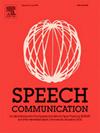利用元音的声学特征估算清醒时上气道横截面积的可行性:试点研究
IF 2.4
3区 计算机科学
Q2 ACOUSTICS
引用次数: 0
摘要
上气道尺寸评估在了解阻塞性睡眠呼吸暂停(OSA)的发病机理方面显示出巨大的前景。然而,目前的 OSA 筛查系统无法对上气道进行客观评估。对上气道的评估可以通过核磁共振成像或 CT 扫描来准确进行,但这些方法成本高昂且不易获得。声学咽喉测量法或超声波检查法可能是成本较低的技术,但这些技术需要训练有素的人员,因此不易获得,尤其是在诊所环境或手术前评估上气道时。在本研究中,我们旨在研究元音发音在评估正常呼吸时上气道尺寸方面的实用性。为此,我们通过声学咽喉测量法测量了上气道横截面积(UA-XSA),然后要求参与者在 3 秒钟内发出 5 个元音,并用麦克风记录下来。我们从所有元音中提取了 710 个声学特征,将这些特征与 UA-XSA 进行了比较,并建立了回归模型来估计 UA-XSA。结果表明,梅尔频率倒谱系数(MFCC)是元音最主要的特征,因为在主要特征集中,9 个特征中有 7 个来自 MFCC。多元回归分析表明,声学特征与人体测量特征的组合在估算 UA-XSA 时的 R2 值为 0.80。元音声学分析的重要优势在于其简单易行,可在可穿戴设备或移动应用中轻松实现。这种基于声学的技术可以在重症监护室等不同的临床环境中使用,也可以在偏远地区使用。因此,这些结果可用于开发用户友好型应用程序,利用声学特征和人口信息来估计 UA-XSA。本文章由计算机程序翻译,如有差异,请以英文原文为准。
Feasibility of acoustic features of vowel sounds in estimating the upper airway cross sectional area during wakefulness: A pilot study
Assessment of upper airway dimensions has shown great promise in understanding the pathogenesis of obstructive sleep apnea (OSA). However, the current screening system for OSA does not have an objective assessment of the upper airway. The assessment of the upper airway can accurately be performed by MRI or CT scans, which are costly and not easily accessible. Acoustic pharyngometry or Ultrasonography could be less expensive technologies, but these require trained personnel which makes these technologies not easily accessible, especially when assessing the upper airway in a clinic environment or before surgery. In this study, we aimed to investigate the utility of vowel articulation in assessing the upper airway dimension during normal breathing. To accomplish that, we measured the upper airway cross-sectional area (UA-XSA) by acoustic pharyngometry and then asked the participants to produce 5 vowels for 3 s and recorded them with a microphone. We extracted 710 acoustic features from all vowels and compared these features with UA-XSA and developed regression models to estimate the UA-XSA. Our results showed that Mel frequency cepstral coefficients (MFCC) were the most dominant features of vowels, as 7 out of 9 features were from MFCC in the main feature set. The multiple regression analysis showed that the combination of the acoustic features with the anthropometric features achieved an R2 of 0.80 in estimating UA-XSA. The important advantage of acoustic analysis of vowel sounds is that it is simple and can be easily implemented in wearable devices or mobile applications. Such acoustic-based technologies can be accessible in different clinical settings such as the intensive care unit and can be used in remote areas. Thus, these results could be used to develop user-friendly applications to use the acoustic features and demographical information to estimate the UA-XSA.
求助全文
通过发布文献求助,成功后即可免费获取论文全文。
去求助
来源期刊

Speech Communication
工程技术-计算机:跨学科应用
CiteScore
6.80
自引率
6.20%
发文量
94
审稿时长
19.2 weeks
期刊介绍:
Speech Communication is an interdisciplinary journal whose primary objective is to fulfil the need for the rapid dissemination and thorough discussion of basic and applied research results.
The journal''s primary objectives are:
• to present a forum for the advancement of human and human-machine speech communication science;
• to stimulate cross-fertilization between different fields of this domain;
• to contribute towards the rapid and wide diffusion of scientifically sound contributions in this domain.
 求助内容:
求助内容: 应助结果提醒方式:
应助结果提醒方式:


